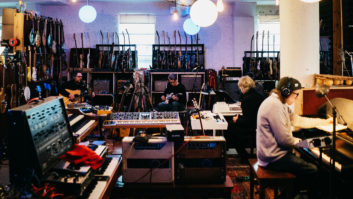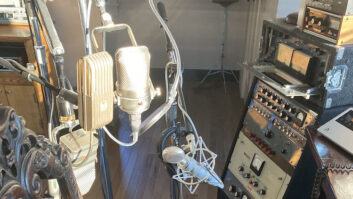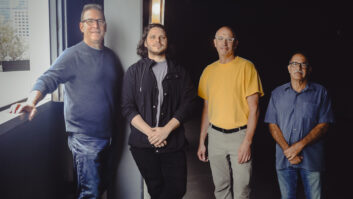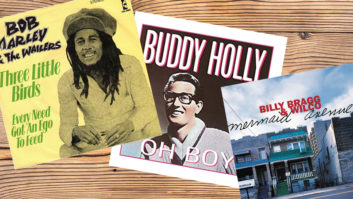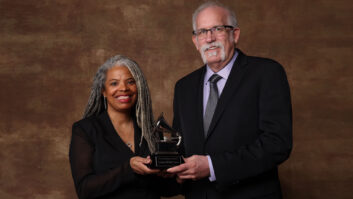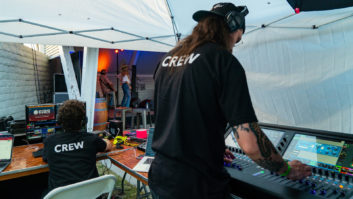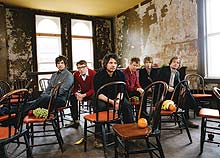
From left: Glenn Kotche, Mikael Jorgensen, Jeff Tweedy, Nels Cline, Pat Sansone and John Stirratt
Photo: Autumn De Wilde
Since coming onto the scene in the mid-’90s, Wilco has consistently been one of the most unpredictable and adventurous American bands, and leader Jeff Tweedy is among music’s most intriguing figures. The three Wilco albums Mix has covered previously — their alt-country debut A.M.; the collaborations with Billy Bragg on songs by Woody Guthrie called Mermaid Avenue; and the eclectic and experimental Yankee Hotel Foxtrot — are all sonically completely different from each other, just as Summerteeth (1999) bears little semblance to the 2007 Sky Blue Sky. Wilco’s latest is called Wilco (The Album), and while it doesn’t represent a radical departure for the group, it’s definitely another left-hand turn down an untraveled road.
“Having had records that people have claimed sound very different for so long…it’s never been our intention not to sound like ourselves,” Tweedy mused this spring to writer Scott Timberg of metromix.com. “I think this [new] record incorporates most of the other periods into an overall package — if anything, it’s like the Whitman’s Sampler record.”
Why now? “This band — which for all of us has become the definitive lineup of Wilco — has been together longer than any other lineup and really feels like what the band was meant to be. When we did the residency shows a year or so ago [five nights at Chicago’s Riviera Theatre in February 2008], this band became conversant with all those other records and able to claim some ownership. Whatever different styles we’d tried on those other records, this band is adept at them, and maybe this [new] record grew out of that experience. I think this record is the least self-conscious and most confident of all the Wilco records.”
As usual, it’s difficult to characterize the songs on Wilco (The Album) because they cross so many stylistic boundaries and draw from many different influences. A lot of Tweedy’s songs have folkish underpinnings, regardless of what style they eventually emerge as, and there are certainly several nods to The Beatles here — “I’ll Fight” has a ringing Beatles ’65 vibe in places; “Everlasting Everything” contains faint echoes of “A Day in the Life”; and the propulsive “You Never Know” sounds like the best song George Harrison never wrote.
But with Wilco, the flashes of familiarity always bubble up from within the greater, unmistakable “Wilco Sound.” That starts with Tweedy’s expressive vocals — always up front, usually (but not always) fairly dry — and then wraps the band around that lead vocal. On this album, there’s plenty of cool lap-steel and slide guitar, fuzzed drones, all sorts of tasteful keys — including piano, organ, harpsichord and an occasional synth — lean, solid bass lines, and drums and percussion that ranges from prominent pounding to subtle splashes, depending on the requirements of the song. The liner notes don’t say who plays what on which song, but it’s a good bet that bass and drums will be John Stirratt and Glenn Kotche, respectively; guitars by Nels Cline, Pat Sansone and Tweedy; and keys by Mikael Jorgensen and Sansone. There are various electronic effects tossed in here and there in small doses, and also a few nice guest spots: Dave Max Crawford on trumpet on a tune, Jason Tobias on slide cimbalom (!) and, most prominently of all, Leslie Feist as duet vocalist on the lovely, affecting folk tune “You and I.” With the notable exception of the edgy and insistent “Bull Black Nova,” Wilco (The Album) is a pleasing and sonorous ride through varying musical and emotional terrain.
This time out, Wilco shared the production responsibilities with Jim Scott, who has mixed Wilco albums dating back to Being There (1996) and certainly is part of the extended Wilco family. Scott, who has worked with so many big names through the years in production, engineering and/or mixing capacities — Petty, Sting, the Chili Peppers, Weezer, Dixie Chicks; the list goes on — and was profiled in Mix‘s February 2009 issue, says the invitation to get involved with Wilco at the tracking stage happened unexpectedly. In October 2008, the band invited Scott to The Loft — the Northside Chicago warehouse space that serves as their headquarters and studio — and asked him to watch them do some tracking and overdubbing on new material.
“They had recorded versions of almost all the songs that are on the new album,” Scott says. “It was fun watching that. I said, ‘Sounds good, looks like it’ll be a great record,’ and then I left. I got a call from Jeff a couple of days later, and he said, ‘Well, what do you think?’ I said, ‘I think the songs are pretty great, but it’s not very exciting. I don’t think it’s as good as you can do. I know it can be better. I think everyone needs to work a little harder.’ I told him in the nicest possible way I didn’t think he was ready to start mixing what I’d heard. And I don’t think he was thinking it was ready to mix, either; I think he was asking, ‘Where do you think we’re at?’ ‘Some good songs, but you need better recordings; let’s shine this up. Let’s do this right!’ So at that point, he asked, ‘Do you want to make a record with Wilco?’

Co-producer/engineer/mixer Jim Scott has worked with Wilco for many years.
Photo: Mr. Bonzai
“As our lives progressed, we found ourselves down in Auckland, New Zealand, in December, working with Neil Finn and a bunch of other really spectacular musicians on the 7 Worlds Collide project [an all-star benefit album and DVD, titled The Sun Came Out, to raise money for Oxfam, set for an early August release]. The plan was to do the Wilco record after this wintertime experiment in New Zealand.” In addition to enlisting four of the six members of Wilco (Cline and Jorgensen were not involved), this 7 Worlds Collide album also brought together Phil Selway and Ed O’Brien from Radiohead, Johnny Marr (of Smiths and Modest Mouse fame), Scottish singer/songwriter K.T. Tunstall, Soul Coughing’s Sebastian Steinberg, multi-instrumentalist Lisa Germano and others. Finn’s first 7 Worlds Collide album, which came out in 2001, featured much of the same cast of musicians, plus Eddie Vedder, but not Wilco or Tunstall. And whereas that album was a live recording, for the 2008-’09 version the musicians convened at Finn’s Roundhead Studios complex, writing songs and recording together in all sorts of different configurations. “We had three studios going at once there,” says Scott, who cut 20 of the 30 songs produced during the month of sessions.
“Everything was going great, and the Wilco songs we recorded for the project were amazing. In fact, everyone agreed it was happening. The studio was great — it has a beautiful old Neve 8048 that came out of The Who’s studio and then was at Bearsville [in upstate N.Y.]. It was summertime down there; just a great vibe all around.
“Like I said, the plan was when that working holiday ended, we were going to go to Chicago to make the Wilco record. But then Jeff said, ‘Hey, do you want to stay a few extra days and start cutting our tracks down here?’ ‘Absolutely!’ So we did; we stayed an extra week and cut them as a four-piece. We cut all the bed tracks for the songs. The vocals are live — Jeff sings and plays live, and when he’s got it, he’s got it. When he serves up the vocal and the groove, everybody plays great. It’s not like, ‘Oh, we need a little piece of this vocal and little piece of that vocal, and here’s a good chorus and here’s a good bridge from that take.’ They’re real musicians and they play well consistently. It’s so refreshing and fantastic to be with a great band.”
Everything was recorded on tape and then transferred to Pro Tools, “and after we’d gotten all our tracks done, we went back to Chicago to work on it some more. So we went from New Zealand summertime to an ice-cold, freezing Chicago winter working at The Loft,” Scott says with a laugh. “The guy upstairs there has a machine shop and there are these presses going all day long — you hear this deep ka-chonka, ka-chonka. So there’s this machine noise and there are also sirens. It’s not built like a recording studio; it’s not all soundproofed and isolated. So you grit your teeth. and say, ‘Okay, if there’s a little siren in the background, that’s the way it goes. If there’s a big machine shop crunch in the middle of Leslie Feist’s vocal, hopefully it will be in time. That’s how it goes.’ They’re used to it, and they’re not the type of people that would be derailed by that anyway.”
On the song “Deeper Down,” for instance, “you can hear some of the sound of the workspace in there. We were saying, ‘Can you believe how loud it is and we’re trying to make a record here?’ Well, you can’t hide it, so we might as well put it on the record and put it where we want it. So we would wait for particularly loud [noises] and record them and sample them and move them into the music to help make the atmosphere.”
The Loft takes up an entire floor of a four-story building and is loosely separated into what Scott calls “little neighborhoods” rather than dedicated rooms. “There’s a control room area, a performance area, plus you can make a ‘drum room’ with baffles,” he says. “There’s storage down on one end [of the floor] and guitar racks and amps through the middle, and everybody who needs a desk has a desk. There are even bunk beds and some guys crash out there. The console is a late-’80s or early ’90s Sony console, which was only used for monitoring.” For Wilco (The Album), Scott brought in his own Neve BCM-10 sidecars, which contain coveted 1073 and 1079 EQs.
As Cline and Jorgenson hadn’t been in New Zealand for the basic tracks sessions, their parts were added back at The Loft. “Nels and I spent a couple of weeks together — he had two or three parts on each song,” Scott says. “I don’t look at it like it was a real created, overdub-y record, but Nels had parts in his mind, parts they had worked out together during the pre-production period before I even got there, and then there were some experiments along the way. One thing always leads to another, and so Mikael would hear something and he’s got some great [keyboard] sounds and really good ideas. All of those guys have a great sense of how to put parts together in interesting ways.”
When it comes to miking guitars, Scott says, “I’ll usually use a Shure 57 and a Neumann 87. It’s the good mic/bad mic thing — the 57 takes a beating and gets all the brightness and crispyness, and the 87 rounds it out on the edges and gives it some character. The combination of those will give you a good electric guitar sound every time.” Scott also called on Royer 121 ribbons on occasion during the Chicago sessions. “I actually prefer older ribbon mics — my [RCA] 44s and 77s — but I didn’t bring them with me and the Royers were great. If it’s the right sound coming out of the amp, the Royer will faithfully record it for you.” Scott also notes that “all the reverb and tremolos on those parts came out of the amps from Nels and Patrick,” rather than being added later during mixing. The song “Everlasting Everything” also benefitted from the addition of a retro-cool Mellotron string part.
For Tweedy’s vocals, Scott used a Shure SM7: “We tried more expensive mics but they weren’t right. Jeff knows that mic, he’s real comfortable with it, and I am, too. I’ve used it on Anthony Keidis’ vocals on Chili Peppers records. There are better mics for different people at different times, but that seems to work best on Jeff.”
Scott mixed the album at his Southern California facility, Plyerz Studios, which is centered around his own Neve 8048 console and is filled to the brim with vintage (and modern) outboard gear. Unlike many bands that quickly max out inputs with layer upon layer of tracks, Wilco generally likes to keep things fairly spare. As Scott notes, “I only have 56 inputs and we never got close to that; maybe 40 or so was the most, on ‘Deeper Down’ or ‘Everlasting.’” All the mixes go through Tweedy, of course, and Scott says, “He has great ears. He’s very decisive and bold. If something’s not quite right, you go give it another shot. He’s not one of those, ‘Well, let’s do a hi-hat up and a bass down, and a guitar on the left louder [mix]’ kind of guy. It’s more like, ‘That sounds great; that’s done. Thank you.’ I love that!
“I bet there aren’t that many alternate mixes of our favorite records — when they were mixed by hand or early computers. When it was done it was done. They might have done a better mix, but not an insecurity mix. That’s the way it is working with Wilco, too.”
